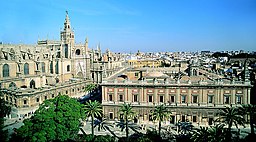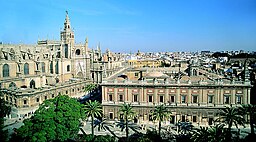
Seville
Seville is a very important city located in the south of Spain. With more than 680000 permanent residents, it is the fourth largest city in Spain. It is also the capital of the province of the same name. Like other Spanish cities, it has a rich history and no generation will be bored when visiting.
Sights of Seville
Seville is full of historical monuments, you will certainly not be enough to visit all of them one day. Therefore, if you do not have enough time, you need to choose your priorities and visit it that interests you the most. Or you will have to spend more days in the city.
Alcázar – today it is a royal palace, but originally it was a Moorish fortress. It is rightly inscribed on the UNESCO World Heritage List.
Seville Cathedral – is also listed on the UNESCO list. It is the third largest cathedral in Europe. Construction began in 1402 and the remains of Columbus are stored here.
Indian Archives – also a UNESCO World Heritage Site. There are stored merchant contracts with the New World, as well as very important documents regarding the discovery of America.
Giralda – is the bell tower of Seville Cathedral, which at the time of its construction was the tallest in the world. The original minaret was later rebuilt in Renaissance style.
Plaza de España – an original square, known from the film screen. Star Wars fans know well.
and many other sights.
Bullfighting Sevilla
Seville has a tradition of bullfighting like few other cities. Although it still has its supporters and opponents, it simply belongs to the city. As early as 1750, local toreadors were having fun with corrida. The local arena can accommodate up to 12500 spectators and is called Plaza der Toros de la Maestranza.
Public transport Seville
Like other European capitals, Seville relies on public transport to get around the city. If you do not have your own car in the city, it is of course the cheapest and easiest way to move around. And if you have a car here, at least you do not have to deal with parking problems in the center.
The backbone of transport in Seville is definitely the metro. The first line has 22 stations and runs through the entire city. The plan is to build more lines, but this is a long-term plan with question marks around financing.
Of course, the metro is complemented by trams and buses. Public transport signs are clear and connections run on time.
Transport Seville
The fastest and, of course, the most comfortable transport to Seville is, of course, the plane. The city has its own san pablo international airport, located about 10 kilometers from the city. Within its country, it is the sixth busiest air port. From the airport to the city you can get either by bus or you can use a taxi, which, of course, is always a little more expensive.
You can also get to the city with the help of a long-distance bus from many European cities.
